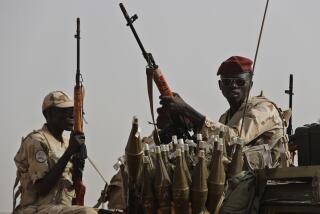Roadside bomb kills 15 Afghan civilians
- Share via
Reporting from Kabul, Afghanistan, and Dubai — A roadside bomb Saturday killed 15 Afghan civilians, including eight children, in a volatile southern district where U.S. forces last year made a major push to dislodge the Taliban, provincial officials said.
The blast was one of a series of attacks across the country that killed at least 21 people in 24 hours, including a Western service member who died in the south.
The scene of Saturday’s roadside bombing, Arghandab district in Kandahar province, saw heavy fighting in the summer and fall of 2010. Military progress in the south, particularly in districts surrounding Kandahar city, was touted as a sign of the success of last year’s U.S. troop buildup. But insurgents in recent weeks have been filtering back into some key areas, seeking to reclaim former strongholds.
Overall violence has been rising since the Taliban declared the start of a spring offensive about six weeks ago. The accelerated tempo of deaths and injuries comes as the White House is weighing the scope of a planned drawdown of U.S. forces.
Senior military officials, including Defense Secretary Robert M. Gates, who visited Afghanistan last week, have said that too quick a reduction in American troop strength could jeopardize territorial gains made by the NATO force.
Improvised explosive devices, or IEDs, are the insurgents’ favored weapon against Western troops, responsible for the majority of military deaths. But as in Saturday’s blast, the buried bombs often maim and kill civilians, who travel on the same roads used by the NATO force.
Those slain Saturday were traveling in a crowded minivan, a common practice in impoverished rural areas. Zalmay Ayoubi, a spokesman for the Kandahar governor, said four women and three men were killed along with the eight children in the vehicle. A woman was injured.
Afghanistan’s Interior Ministry blamed insurgents for what it called an “inhumane and cowardly” act.
Civilian casualties have reached some of their highest levels of the war, with nearly 2,800 killed last year, and deaths in May reached a four-year high for that month, according to the United Nations. The Taliban and other insurgent groups are responsible for most of those deaths and injuries, but smaller numbers of casualties caused by foreign troops are a principal source of friction between the Western military and the government of President Hamid Karzai.
Noncombatants are often caught up in attacks aimed at Western troops or Afghan military installations. That happened Saturday in the eastern province of Khost, where a suicide bomber struck the headquarters of a police quick-reaction force.
The attacker blew himself up outside the compound gates, killing the force’s commander and a bodyguard. A provincial spokesman said the blast also hit a group of bystanders, killing a 12-year-old boy and injuring eight people.
Also Saturday, officials in Laghman province, east of the capital, Kabul, said three police officers had been killed in a bombing the night before while on patrol. The attack occurred in the district of Mehtar Lam, one of seven areas across the country where Afghan forces are to begin assuming security responsibilities next month. Nearly every area on that list has been hit by a recent attack.
As the traditional fighting season gathers pace, it is unusual for a day to pass without at least one military fatality, sometimes several. On Saturday, the NATO force said a service member had been killed in Afghanistan’s south, but did not provide the nationality.
Special correspondent Baktash reported from Kabul and Times staff writer King from Dubai.
More to Read
Sign up for Essential California
The most important California stories and recommendations in your inbox every morning.
You may occasionally receive promotional content from the Los Angeles Times.










